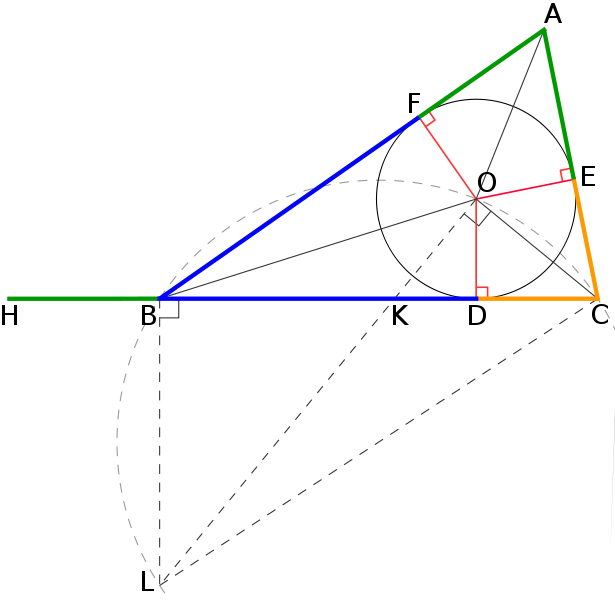Does it exist?
 Determine whether the following statement is TRUE or FALSE.
Determine whether the following statement is TRUE or FALSE.
There exists a triangle having all sides of length more than 1 0 0 c m but with area less than 1 c m 2 .
This section requires Javascript.
You are seeing this because something didn't load right. We suggest you, (a) try
refreshing the page, (b) enabling javascript if it is disabled on your browser and,
finally, (c)
loading the
non-javascript version of this page
. We're sorry about the hassle.
8 solutions
Hmmm... actually not. triangle has to be obtuse for this to hold true. As per your statement, if the length of the other 2 sides are greater than 200, then it will be equal(you mentioned isosceles). In that case, you cannot form an obtuse angled triangle with 200, 201 and 201. (side1)^2 > side2^2 + side3^2 for obtuse angled triangle. You can't frame such triangle with your statement. So the equal side must be lesser than the third side. If you take a acute triangle 3 side will not be greater than 100 and the condition fails.
Log in to reply
Actually, Peng Ying Tan is right... What he said is that the TOTAL length of the remaining two sides is greater than 200... And since the triangle is isosceles, they will each be greater than 100... And so the resulting triangle is obtuse angled...
Very surprising!!
use the heron's formula and take the length of each side 100cm the area of triangle form is 53033.008 and it is the min. value for triangle of side length 100cm
dimention of height is not possible cm2.
The correct way to prove this, is to take an isosceles triangle. Fix the base as 101 and the opp side(just a notation) as also 101. Extrapolate the base to form a right angled triangle with the vertex of the opp side and the hypotenuse. From the right angled triangle, we can estimate that critical angle = Inv sin (h/101) . The obtuse angle of the triangle is 180 - critical angle. For the area to be 1 cm^2, the height has to be (2/101) fixing the base as 101. Sub this in the critical angle formula; you will get that as 0.01 degrees approx. So, the obtuse angle of the triangle has to be greater than (180 - 0.01) and lesser than 180. The epic statement :P LHS = RHS and hence proved.
Math man it won't form a triangle, try it out take scale and pen and draw it. There will be line only :D Because for a triangle to exist, sum of its any two side must be greater than the other
He meant a value x that "tends" to 100
"a>b+c" guys :D
I could be wrong :) Let be a triangle whose sides are respectively 1 0 2 c m , 1 0 2 c m and 1 0 3 c m . Then, calculate the triangle's area by using the second theorem of trigonometry: A = a × b sin θ . Since the area must be less than 1 c m 2 , we have to solve 2 1 0 2 × 1 0 2 sin θ < 1 a n d 2 1 0 2 × 1 0 2 sin θ < 1 a n d 2 1 0 2 × 1 0 3 sin θ < 1 . The first and the second inequalities are equivalent, so just one of them can be solved. The overall solution is sin θ < 5 2 5 3 1 , that is 0 < θ < sin − 1 ( 5 2 5 3 1 ) o r π − sin − 1 ( 5 2 5 3 1 ) < θ < π . Hence, it exists at least one triangle that turns the statement TRUE.
Just by a counter example, choose an isosceles triangle whose base measures 300 cm and height of 1/300 cm
let two sides be 100.0000004cm and the other side 200cm.
So the perpendicular from vertex
=sqrt(100.0000004^2 - 100^2) = 0.008944.
The area = (1/2)200* 0.008944 < 1sq.cm.......................................................................................
There was no need to give the diagram. It was misleading.
I am so good with geometry* that I did this:
"0.5 * 200 * 100 * tan(0.00001) < 1"
and it evaluated to True.
* If you are slow, that was sarcasm.
Area = 1/2 base ht ... Base=100.1 cm, Ht=2 divided by 100.1 = 20/1001 of a cm. Any line meeting the apex will be greater than 100.1, therefore validating the statement.
What abt the "all" sides being more than 100 cm
Log in to reply
Generalise it. Take the 3 sides as 100+x, 100+y and 100+z. Choose any one of the three as base (say 100+x). Plug 100+x into the 1/2 base height formula and solve for height. You'll get height equals 2/(100+x). If you can find any value for x for which height is positive (height>0), the triangle can exist.
The area will be 4325
Take an isosceles triangle with base 200cm and height 2 0 0 1 c m 2 . The total length of the rest two sides(equal) must be longer than 200cm so the each side is longer than 100cm. The area of that triangle is 0 . 5 c m 2 . Therefore the statement is TRUE.
Haha. It really exists! :-D